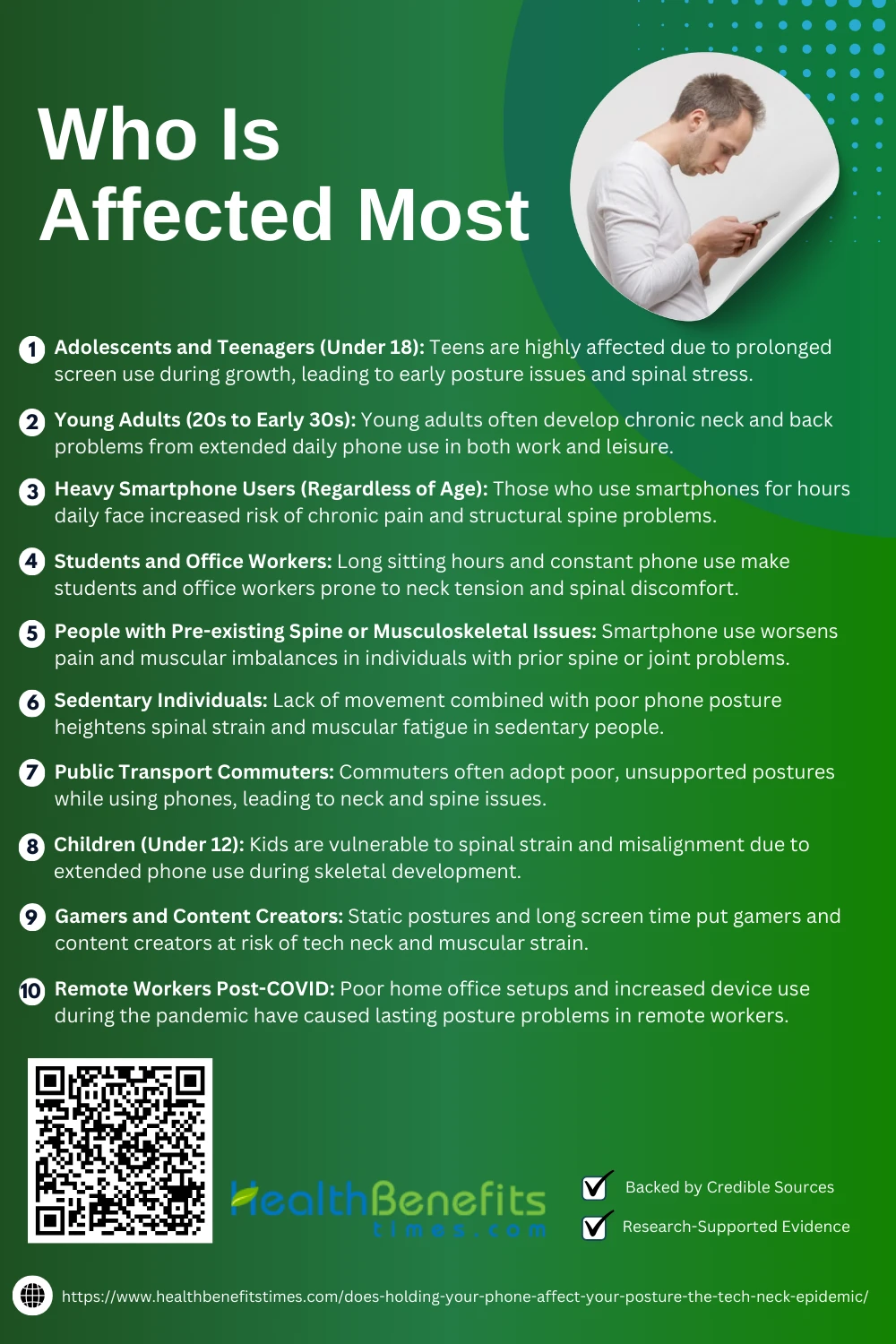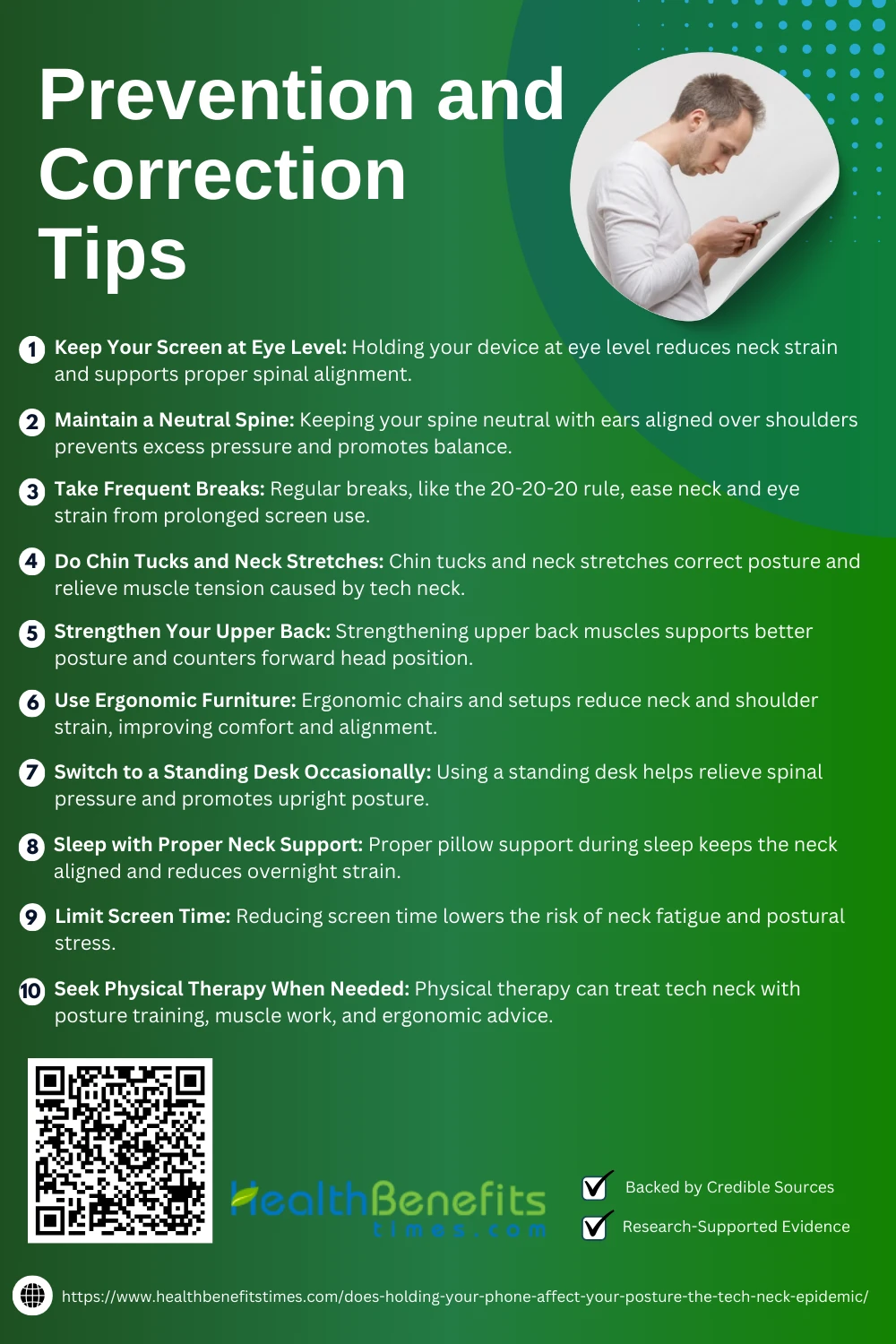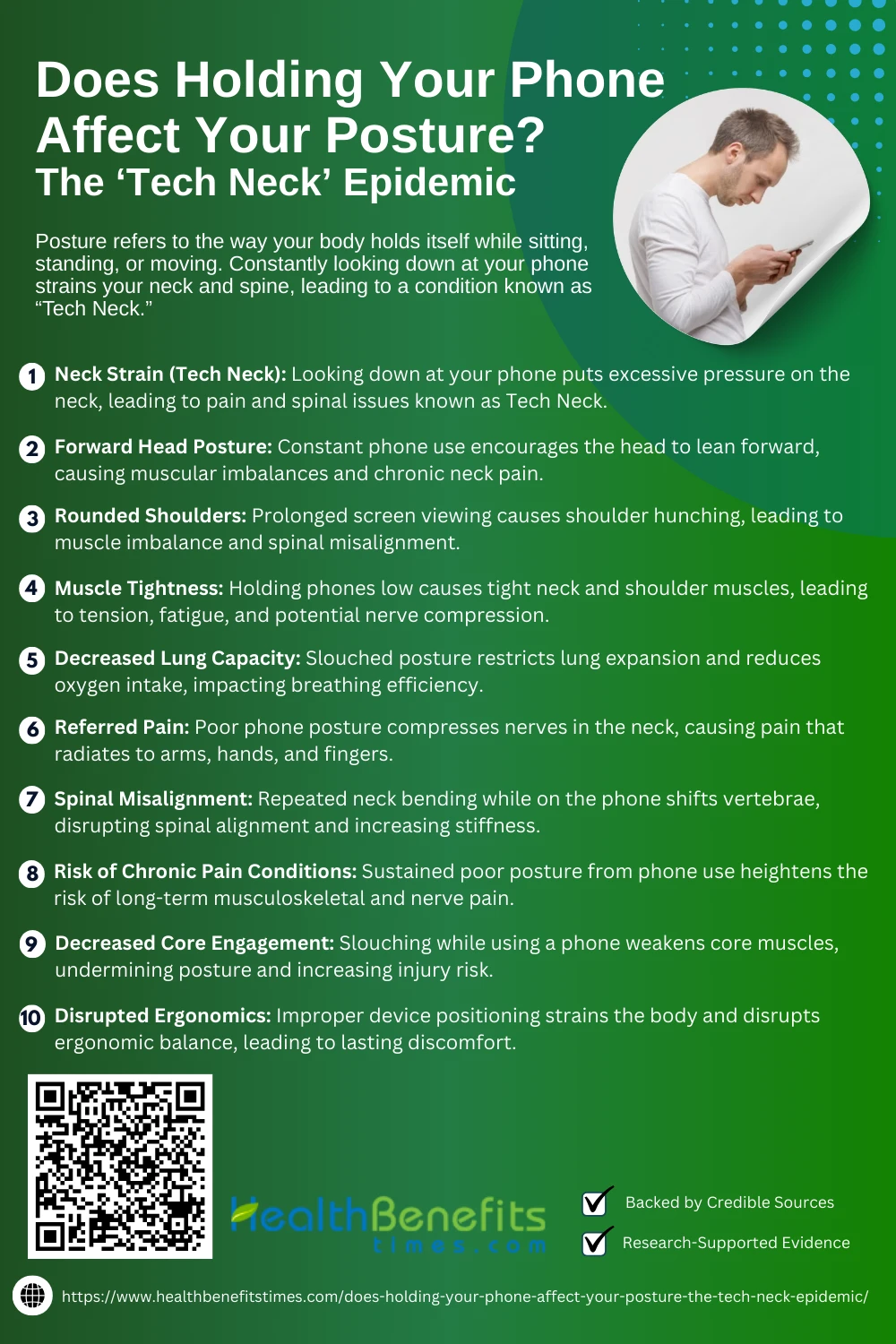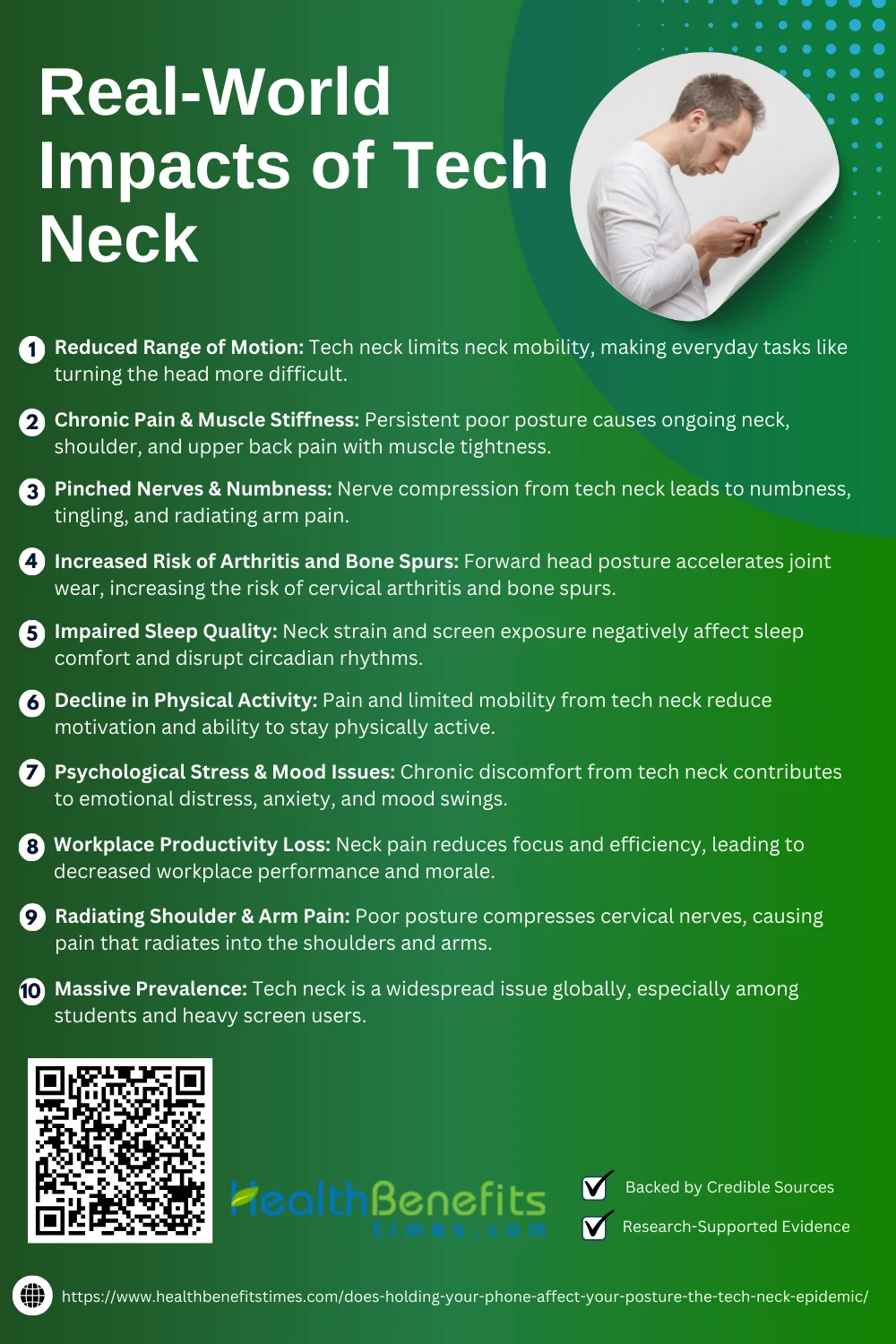- Posture refers to the way your body holds itself while sitting, standing, or moving.
- Constantly looking down at your phone strains your neck and spine, leading to a condition known as “Tech Neck.”
- Tech Neck can cause chronic pain, poor posture, and long-term health issues if not addressed early.
 Posture refers to the alignment and positioning of the body in relation to gravity—whether standing, sitting, or lying down—and plays a critical role in musculoskeletal health. In the modern digital era, the habitual act of looking down at a smartphone for extended periods has given rise to a growing health concern known as “Tech Neck”—a condition linked to poor cervical posture and chronic musculoskeletal discomfort. Studies show that tilting the head forward while scrolling or texting exerts increasing pressure on the cervical spine, significantly more than in a neutral position. This seemingly minor daily behavior, when repeated for hours, contributes to muscle strain, forward head posture, and even long-term spinal misalignment. A recent study conducted in Saudi Arabia emphasized the association between smartphone use and the onset of neck pain and postural issues among frequent device users. Furthermore, researchers have begun to call for a paradigm shift in managing this syndrome, urging a move from simple posture correction to broader behavioral change in device usage. With mobile screen time at an all-time high globally, understanding the physical repercussions of how we hold our phones has never been more urgent.
Posture refers to the alignment and positioning of the body in relation to gravity—whether standing, sitting, or lying down—and plays a critical role in musculoskeletal health. In the modern digital era, the habitual act of looking down at a smartphone for extended periods has given rise to a growing health concern known as “Tech Neck”—a condition linked to poor cervical posture and chronic musculoskeletal discomfort. Studies show that tilting the head forward while scrolling or texting exerts increasing pressure on the cervical spine, significantly more than in a neutral position. This seemingly minor daily behavior, when repeated for hours, contributes to muscle strain, forward head posture, and even long-term spinal misalignment. A recent study conducted in Saudi Arabia emphasized the association between smartphone use and the onset of neck pain and postural issues among frequent device users. Furthermore, researchers have begun to call for a paradigm shift in managing this syndrome, urging a move from simple posture correction to broader behavioral change in device usage. With mobile screen time at an all-time high globally, understanding the physical repercussions of how we hold our phones has never been more urgent.
What is Tech Neck?
Tech Neck, also known as Text Neck, is a modern term used to describe the strain and discomfort resulting from prolonged forward head posture, typically while looking down at mobile devices. First coined by a U.S. chiropractor, the term highlights a posture-related syndrome linked to the widespread adoption of smartphones and tablets.
Common symptoms include neck and shoulder pain, stiffness, reduced range of motion, and in severe cases, spinal degeneration. Many individuals also report chronic headaches, tingling in the arms, and muscle fatigue. In one study, over 70% of young adults experienced musculoskeletal pain linked to digital device usage.
Phone use of more than 4 hours per day significantly increases the risk of developing Tech Neck. The severity of symptoms often correlates with screen time and the angle at which the device is held.
How Holding Your Phone Affect Your Posture?
Constantly looking down at your phone may seem harmless, but over time it can seriously affect your posture, leading to pain, stiffness, and a growing issue known as “Tech Neck.”
Holding your phone at a low angle forces your neck into a forward tilt, increasing the load on your cervical spine. This can lead to a condition known as Tech Neck, where pressure on the neck increases from 10-12 pounds to nearly 50 pounds when the head tilts at 45 degrees. This repetitive strain can affect the facet joints, irritate spinal discs, and lead to referred pain in the arms. (1) (2) Long-term effects may include nerve compression, headaches, and posture imbalance. (3)
2. Forward Head Posture
Repeatedly looking down at mobile screens promotes Forward Head Posture (FHP), a musculoskeletal imbalance where the head protrudes past the spine’s neutral alignment. This stresses suboccipital muscles and weakens anterior neck muscles. (4) FHP increases spinal disc compression and fatigue in the upper back. (5) Over time, it may cause persistent neck stiffness and chronic pain. (6) Prolonged device use in such positions can even contribute to text neck syndrome and upper thoracic joint immobility. (7) (8)
3. Rounded Shoulders
Extended smartphone use often leads to rounded shoulders, as users instinctively hunch forward to view their screens. This posture causes the shoulder blades to drift forward, overloading the upper back and chest muscles (Hogan Chiropractic). (4) The resulting imbalance shortens the pectoral muscles and weakens the scapular stabilizers (Mayo Clinic). (1) Over time, this can lead to long-term spinal misalignment and contribute to text neck syndrome. (7) (6) Preventive adjustments, such as ergonomic device positioning, are essential. (5)
4. Muscle Tightness
Holding your phone at chest or waist height for prolonged periods promotes muscle tightness, especially in the neck and shoulders. This forward-flexed position leads to excessive strain on neck flexors and upper trapezius muscles. (9) Overuse may cause tension and tenderness in muscles, contributing to fatigue and pain. (1) Chronic tightness may escalate into tendonitis in the wrists or forearms. (10) Additionally, smartphone use can compress nerves, producing numbness or tingling sensations. (11) Stretching and posture breaks help alleviate tightness. (12)
5. Decreased Lung Capacity
Prolonged slouched posture while using smartphones compresses the rib cage and diaphragm, impairing lung expansion and reducing respiratory efficiency. Studies show that slumped sitting reduces lung function compared to upright postures. (13) This posture limits diaphragmatic movement and increases intra-abdominal pressure. (14) The chronic forward lean decreases oxygen intake and circulation. (15) Mobile device use worsens this issue with sustained kyphosis, directly impacting breathing capacity. (16) (17)
6. Referred Pain
Holding your phone for extended periods can strain the cervical spine and compress nerves, causing pain that radiates beyond the neck. This referred pain often spreads to the shoulders, arms, and hands as a result of pressure on the nerve roots. (1) Known as “text neck,” this condition can trigger tension throughout the upper body. (9) Persistent overuse may lead to nerve compression disorders like carpal tunnel and repetitive strain injuries. (18) (19) Even elbows and fingers may experience symptoms, known as “cell phone elbow”. (20)
7. Spinal Misalignment
Constantly looking down at a smartphone places repetitive stress on the cervical and thoracic spine, causing vertebral shifts and spinal misalignment. Over time, this misalignment contributes to chronic neck stiffness and muscular imbalances. Prolonged phone use alters the natural curvature of the spine, with up to 60 pounds of pressure applied during forward head posture. Such strain accelerates spinal degeneration and affects respiratory function. (13)
8. Risk of Chronic Pain Conditions
Improper phone posture significantly raises the risk of chronic pain disorders by overloading spinal structures and muscles. Sustained neck flexion increases disc and ligament pressure in the cervical spine. (21) This imbalance can trigger persistent pain in the neck, shoulders, and lower back. (16) Prolonged poor alignment disrupts nervous and vascular systems, compounding pain severity. (22) Widespread musculoskeletal discomfort is also reported across upper limbs and worsened by repetitive stress injuries like text neck. (23) (7)
9. Decreased Core Engagement
Using smartphones while slouching reduces core muscle activation, weakening the body’s natural postural support system. When seated in a collapsed or flexed position, the abdominal and lumbar stabilizers disengage, undermining spinal alignment. (16) Poor posture during screen time diminishes neuromuscular coordination in the trunk muscles. (24) This leads to overcompensation by other muscles, further increasing injury risk. (9) Ergonomic deficits during phone use hinder core endurance and promote muscular imbalances. (25) (1)
10. Disrupted Ergonomics
Smartphone use often leads to disrupted ergonomics due to non-neutral body positioning, especially when devices are held below eye level. This fosters forward head posture and shoulder slumping. (1) Prolonged use in awkward positions strains muscles and joints, contributing to discomfort and long-term posture issues. (9) Poorly designed workspaces lacking ergonomic support worsen these effects. (25) Frequent improper angles during use reduce musculoskeletal efficiency and exacerbate spinal stress. (24) (16)
Who Is Affected Most?
Tech neck doesn’t discriminate, but teens, young adults, and office workers are most affected due to prolonged screen time, poor posture habits, and daily dependence on smartphones and digital devices.
 1. Adolescents and Teenagers (Under 18)
1. Adolescents and Teenagers (Under 18)
Adolescents are among the most affected by smartphone-induced posture issues due to their frequent and prolonged use of mobile devices during critical growth stages. Sustained forward head posture in teens can alter spinal alignment and increase musculoskeletal stress. (1) Research shows that poor posture in this age group often results in neck and back pain, even during early adolescence. (13) Social media usage habits further reinforce slouched positions and spinal strain. (26)
2. Young Adults (20s to Early 30s)
Young adults in their 20s and early 30s are especially vulnerable to smartphone-induced posture issues due to prolonged daily device use in work and leisure. Continuous head-forward positioning strains the cervical spine, leading to early signs of muscular fatigue and spinal misalignment. (13) “Text neck” syndrome is particularly prevalent in this age group, with symptoms like stiffness and pain becoming chronic over time. (7) This demographic also frequently experiences back tension and disc pressure due to poor sitting posture. (27)
3. Heavy Smartphone Users (Regardless of Age)
Heavy smartphone users—those spending several hours daily on their devices—face the most pronounced posture-related health risks. Prolonged phone use leads to increased cervical disc pressure and muscle imbalances, especially from sustained forward head posture. (21) This repetitive strain results in chronic neck and upper back pain. (13) Overuse also exacerbates conditions like “text neck,” causing long-term structural issues and discomfort. (7)
4. Students and Office Workers
Students and office workers are especially vulnerable to smartphone-induced posture problems due to extended sitting combined with frequent mobile device use. The repetitive forward head posture leads to “tech neck,” characterized by neck stiffness and shoulder tension. Over time, this posture causes spinal stress and musculoskeletal discomfort. (16) Among students, prolonged usage also negatively impacts cognitive focus and contributes to physical fatigue. (28)
5. People with Pre-existing Spine or Musculoskeletal Issues
Individuals with pre-existing spinal or musculoskeletal conditions are more susceptible to worsened symptoms from poor smartphone posture. Sustained forward head positioning can aggravate cervical and lumbar spine issues, amplifying pain and stiffness. (16) Prolonged smartphone use may lead to referred pain in the shoulders, arms, and hands for those already vulnerable. (23) These individuals often experience exacerbated muscular imbalances and fatigue due to device overuse. (13)
6. Sedentary Individuals
Sedentary individuals, who already exhibit reduced muscular engagement, are particularly vulnerable to smartphone-induced posture problems. Prolonged sitting paired with forward head tilt from phone use worsens spinal loading and leads to imbalanced posture patterns. (13) This contributes to musculoskeletal fatigue and strain in the cervical and lumbar regions. (1) Additionally, prolonged screen viewing in seated positions increases head and neck flexion angles, reducing postural recovery capacity.
7. Public Transport Commuters
Public transport commuters often adopt poor postures due to limited seating ergonomics and extended device use during travel. Slouched, unsupported postures while scrolling on smartphones cause excessive neck flexion and spinal misalignment. (26) Repetitive forward head posture, especially in cramped spaces, heightens pressure on the cervical spine. (13) The lack of back support and hand positioning further exacerbates musculoskeletal fatigue and stiffness. (1)
8. Children (Under 12)
Children under 12 are especially vulnerable to posture problems caused by smartphone use due to ongoing skeletal development. On average, kids in this age group spend four to six hours a day on screens, often in slouched positions that lead to “tech neck”. Research shows these prolonged positions can result in spinal ligament strain and cervical misalignment. (13) Text neck syndrome is increasingly being diagnosed in young children.
9. Gamers and content creators
Gamers and content creators often maintain static postures for hours while using smartphones, contributing to serious musculoskeletal issues. Repetitive forward head posture and limited movement cause strain in the neck, shoulders, and lower back. (13) Prolonged screen focus also leads to poor spinal alignment and decreased core engagement. (1) Over time, these factors contribute to posture-dependent injuries like text neck and upper crossed syndrome. (16)
10. Remote workers post-COVID
Since the COVID-19 pandemic, remote workers have seen a sharp rise in posture-related issues due to increased screen time and poor home office ergonomics. Extended smartphone use, combined with makeshift workspaces, has intensified forward head posture and spinal strain. Studies reveal increased cervical spine pressure and musculoskeletal discomfort from digital overuse during remote work. (13) Poor posture habits formed during lockdowns continue to affect this demographic long-term. (1)
Real-World Impacts of Tech Neck
Tech neck can lead to chronic pain, reduced mobility, headaches, and long-term postural changes. These real-world impacts affect daily life, work performance, sleep quality, and overall physical and mental well-being.
Tech neck significantly reduces cervical mobility, making it difficult to perform everyday tasks like turning your head while driving or checking blind spots. This limitation stems from chronic muscle tension and joint stiffness caused by forward head posture, cervical misalignment, and radiating discomfort into surrounding areas. (29) (30) (31)
2. Chronic Pain & Muscle Stiffness
Prolonged smartphone use leads to tech neck, where repetitive strain causes chronic pain and muscle stiffness. This tension primarily affects the neck, upper back, and shoulders due to prolonged head-forward positioning. (29) Sustained posture imbalance also contributes to joint inflammation and myofascial tightness in surrounding muscle groups. (32) (31)
3. Pinched Nerves & Numbness
Tech neck can compress cervical nerves, leading to numbness, tingling, or radiating pain in the arms and hands. This occurs when repetitive neck flexion strains spinal discs and narrows nerve passageways. (29) These symptoms often mimic carpal tunnel syndrome and are increasingly seen in heavy screen users. (31) (30)
4. Increased Risk of Arthritis and Bone Spurs
Tech neck accelerates joint degeneration, increasing the risk of cervical arthritis and bone spur formation. Constant downward head posture places excessive pressure on vertebral joints and discs, speeding up wear and tear. (29) Over time, this stress can lead to chronic inflammation, disc thinning, and joint calcification. (32) (31)
5. Impaired Sleep Quality
Tech neck can significantly disrupt sleep by causing chronic discomfort that makes it difficult to relax or find a restful position. Forward head posture and neck strain from prolonged smartphone use are linked to poor sleep quality and muscle pain. (33) Regular screen exposure before bed also delays circadian rhythms (Sleep Health Foundation) and heightens sleep disturbances. (34)
6. Decline in Physical Activity
Tech neck reduces motivation and capacity for physical activity due to persistent pain and restricted mobility. Strain on neck and shoulder muscles creates postural imbalances that limit motion and function. (35) Fatigue and nerve pressure further discourage movement, while chronic pain often leads to reduced exercise engagement. (1) (36)
7. Psychological Stress & Mood Issues
Tech neck contributes to psychological stress by disrupting physical comfort and triggering chronic discomfort, which affects emotional well-being. Studies show that neck pain is closely linked to depression and anxiety symptoms. (37) Poor posture also impairs breathing and blood flow, worsening mood and irritability. (38) Long-term stress from pain can further lead to burnout and emotional instability. (39)
8. Workplace Productivity Loss
Tech neck hampers workplace productivity by decreasing performance due to persistent neck and shoulder symptoms. Most productivity loss stems not from absenteeism, but from reduced efficiency during work hours. (40) Chronic discomfort can lead to frequent posture adjustments, distraction, and missed deadlines. (41) Unaddressed symptoms may result in prolonged work impairments and lowered morale. (6)
9. Radiating Shoulder & Arm Pain
Tech neck can compress cervical nerves, causing radiating pain in the shoulders, arms, and hands. This referred pain stems from spinal nerve irritation due to poor head posture and disc pressure. (1) It may also involve symptoms like tingling or numbness from cervical radiculopathy and chronic upper body tension. (42) (43)
10. Massive Prevalence
Tech neck has reached alarming global prevalence, especially among students and remote workers. One study found 46.3% of university smartphone users exhibited symptoms of tech neck syndrome. (44) Other research estimates 72% prevalence among college-aged users (NJPPP Study PDF). Globally, neck pain affected over 200 million people in 2020 alone. (45)
Prevention and Correction Tips
Preventing and correcting tech neck starts with better habits—raising your phone, taking breaks, stretching, and strengthening your neck and shoulders can make a big difference in improving posture and reducing pain.
 1. Keep Your Screen at Eye Level
1. Keep Your Screen at Eye Level
Keeping your device at eye level reduces the forward tilt of your head, which significantly lowers the strain on your cervical spine. This posture minimizes muscle overload and prevents disc compression. (3) It’s a proven strategy to combat neck fatigue and maintain ergonomic alignment during screen use. (46) (29)
2. Maintain a Neutral Spine
Maintaining a neutral spine—where your ears align with your shoulders—ensures even weight distribution and reduces neck strain. This position helps protect spinal discs from excessive pressure, promotes muscular balance, and supports long-term postural health during screen time. (1) (46) (3)
3. Take Frequent Breaks
Taking frequent breaks helps reduce continuous spinal strain caused by prolonged screen use. Experts recommend the 20-20-20 rule—every 20 minutes, look 20 feet away for 20 seconds—to relax neck and eye muscles. (47) Short breaks restore postural balance and help counter cumulative stress. (3) (1)
4. Do Chin Tucks and Neck Stretches
Chin tucks and neck stretches are effective exercises to reverse the muscle imbalances caused by tech neck. Chin tucks strengthen deep neck flexors and reduce pain-inducing tension. (48) Side neck stretches improve mobility and flexibility. (49) Integrating these exercises daily supports posture correction. (3)
5. Strengthen Your Upper Back
Strengthening the upper back improves posture stability and helps counteract the forward head position caused by device use. Exercises like chin tucks and shoulder blade squeezes are highly effective. (3) Training muscles like the rhomboids and trapezius supports spinal alignment and reduces neck hump formation over time. (50) (48)
6. Use Ergonomic Furniture
Using ergonomic furniture helps maintain proper posture by supporting the spine and reducing muscular strain. A supportive chair and monitor setup reduce neck flexion and shoulder tension. (51) Ergonomic chairs also minimize fatigue and musculoskeletal risk. (52) Even simple home setups—like a towel roll for lumbar support—can improve comfort. (53)
7. Switch to a Standing Desk Occasionally
Switching to a standing desk periodically promotes better posture by aligning your screen at eye level and relieving pressure on the cervical spine. (3) Research shows standing desks can reduce back and neck pain by over 50%. (54) Chiropractors also recommend them for long-term postural support. (55)
8. Sleep with Proper Neck Support
Proper neck support during sleep helps maintain spinal alignment and reduce overnight strain on cervical muscles. Back sleepers benefit from a small pillow beneath the neck, while side sleepers should keep the spine neutral with layered support (Hinge Health). (56) A well-aligned sleep position minimizes stiffness and promotes long-term neck health (Sleepopolis; Synergy Rehab). (57)
9. Limit Screen Time
Reducing screen time minimizes prolonged neck flexion, lowering the risk of muscle fatigue and spinal strain. Experts recommend taking breaks every 30–60 minutes to reset posture and avoid cumulative damage. (3) Maintaining visual comfort through screen positioning also alleviates strain. (1) (51)
10. Seek Physical Therapy When Needed
When self-care isn’t enough, physical therapy provides targeted solutions for tech neck recovery. Therapists use posture training, manual adjustments, and muscle strengthening to reduce pain and correct imbalances. (58) Combined with ergonomic changes, therapy accelerates healing and prevents future strain. (3) (48)
When to Seek Professional Help
If tech neck pain becomes persistent, radiates into your shoulders or arms, or disrupts your daily routine, it’s time to consult a chiropractor or physical therapist. Other red flags include tingling, numbness, or limited neck mobility lasting beyond a few weeks despite self-care. (59) (3) Early intervention can prevent worsening symptoms or spinal complications. (60)
Professional treatment for tech neck includes manual therapy, postural retraining, and therapeutic exercises tailored to relieve strain and realign the spine. Chiropractors may use spinal adjustments, while physical therapists implement guided stretches, ergonomic training, and resistance exercises. (61) Massage therapy and heat or ice application may also complement care plans. (3)
Conclusion
In today’s digital world, it’s easy to overlook how much time we spend hunched over our phones. But as the tech neck epidemic shows, poor posture from prolonged device use can lead to serious discomfort and long-term health issues. Fortunately, small changes—like holding your phone at eye level, taking regular breaks, and doing simple stretches—can go a long way in protecting your spine and well-being. Awareness is the first step. By recognizing the signs early and making posture a priority, you can avoid the pitfalls of tech neck and maintain a healthier, pain-free lifestyle in our screen-filled lives.




